All the Lehigh news first since 1894.
A group of Lehigh students believed the school needed a newspaper after the university had been around for almost 30 years. The university president, Henry Coppee, found out about their idea and asked one of the students, William Anderson, why they didn’t tell him.
Jack Lule, a professor and chair of the journalism department, said the student told the president they simply didn’t think they had to ask permission and were just going to create it.
And so they did.
For 125 years, The Brown and White has been publishing print copies every Tuesday and Friday, except during World War I, when they downsized to a weekly paper, and holding press nights every Sunday and Wednesday. Lule calls this consistency remarkable.
“I think the great thing that The Brown and White does for the university is it charts and captures its history, so if you need to know or want to know anything of what’s been going on in the university over its entire run, The Brown and White is the place to go to it,” Lule said.
The paper is open to students of all colleges, which Lule said has benefits to the paper’s vitality and breadth of its coverage. This was true even in the beginning, as there wasn’t a journalism department established in 1894.
A division for journalism at Lehigh was created in the 1920s before a full department was created, which Lule said is unusual to have a dedicated department to journalism in this size of university.
Lule said he thinks The Brown and White is the reason for the formation of the department.
“I think the administration thought after (about) 20 years of The Brown and White coming out, they thought ‘well this paper isn’t going anywhere, I think these students better get a good education,’” Lule said.
When the department was created, there were only two professors at the time, Joseph McFadden and Robert Sullivan. Lule said McFadden, who was head of the department for 30 years and adviser to the newspaper, was a revered professor to many of his students.
Scott Cagan, ’85, was editor in chief in the fall 1984 semester. He said he still remembers Sullivan, who was the adviser for The Brown and White during his time at Lehigh, and the lessons he learned from him. He said Sullivan was an inspiration, tough yet fair.
Because of the small classroom sizes, Cagan said Sullivan was able to know all the students well and that all the students respected him.
“He really instilled in me to strive for perfection,” Cagan said. “I still remember him sitting in some of my journalism classes with his cigar in his mouth not lit… he really was the all time greatest.”
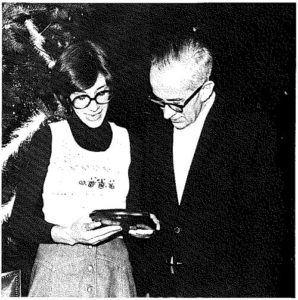
Eileen Canzian, ’77, stands with journalism professor Robert Sullivan during the fall of 1976. Eileen was the first female editor in chief of The Brown and White in the fall semester of 1976. (Courtesy of the Epitome Yearbook)
Eileen Canzian, ’77, director of enterprise and investigation at The Baltimore Sun, said that the advisers and professors gave helpful advice that helped shape her as a journalist.
“I really can’t understate how important the professors in that department were to my development as a journalist and they gave me the foundation to keep growing into the journalist I am today, and I am very proud of the journalist I am today,” Canzian said.
Professor Lule agrees that the advisers are the most important people in the lives of most of The Brown and White students.
During 2014, there was a rebranding, which included the hiring of a new professor that became the adviser to the newspaper. The department hired Matt Veto in 2013 to fulfill this role.
“The hiring of Matt Veto was one of the most important things The Brown and White has done in the past few years,” Lule said. “He has just revolutionized the paper in so many ways.”
The publication’s impact
Cagan said the paper was always student-run and that the journalism professors would not attempt to censor anything they wrote.
Professor Wally Trimble approached Cagan and his peers at The Brown and White after Cagan’s story about a gay alliance group that had formed and who were coming out for the first time.
“(Trimble) said ‘Scott, your story could have run in The Morning Call,’ and he said it was just professional and well-done and felt the need to compliment us on it,” Cagan said. “It was important to set an example and we felt like responsible journalists who needed to present the news as accurately as possible.”
Smith can also recall impactful stories about the university written during her time at the student newspaper including a story questioning if Greek life is inclusive and another about rape culture at colleges.
“Just because we are a student newspaper doesn’t mean we can’t tackle really important stories,” Smith said.
Lule said today, the publication tries to also extend its reach to coverage of the surrounding Bethlehem community.
Cagan said some students would come up to him on campus and talk about some of the recent articles, which he said would often center around sports.
Smith recalled a time where she was able to publish the news immediately. During her semester as editor in chief, President John Simon was announced as the new president of the university. Smith was not only able to set up a Q&A interview with him, but also break the news.
Lule said administration might not always be happy with what the publication writes about, but they have never tried to close the student publication or suspend any of its editors.
“To me, it’s really a testimony to Lehigh students that they want to be involved, that they are not afraid to write and that they are not afraid to write publicly – that says a lot to the students,” Lule said.
During the 1970s, some of The Brown and White included coverage on the integration of women to the university.
Canzian was part of the third female class and was the first female editor in chief at The Brown and White during the fall 1976. She said she didn’t see it necessary to point that fact out. However, the preceding editor in chief, Marty Baron, ’76, who is now the executive editor of The Washington Post, and the advisers said it was a prominent moment.
“I have always thought of myself as a journalist,” Canzian said. “I knew I wanted to be a professional journalist. I thought of myself as a journalist then, and I never thought of myself as a ‘woman journalist.’”
She said she remembers only one time where she felt like she was classified as a woman journalist and that was covering the marching band’s policy not to accept women. She said while interviewing the student leader of the band, he didn’t mention that women weren’t included because they weren’t good musicians but because the group had camaraderie and they thought adding women would ruin this.
After the story was published, Canzian said she believed the band and the administration realized how bad this must have looked.
At a football game during family weekend with her parents shortly after its publication, the marching band played during halftime. As they played “There is Nothing Like a Dame,” some of the members removed their marching caps and long hair tumbled out to reveal there were females playing alongside the band.
Canzian commends the bravery that must have took for the women. She said shining a spotlight on issues for students to see the various facts allows people to have a conversation or debate.
The paper not only impacted the readers, but also the staff.
Cagan said writing on The Brown and White and holding editor positions allowed him to develop leadership qualities and skills that he still uses today as a shareholder lawyer at Gray Robinson firm, such as in writing up depositions and interrogating witnesses.
He said he believes being a strong writer is beneficial in any discipline, and he attributes his own success in his career to his time at The Brown and White.
Smith said at her job as a reporter at Bloomberg Environment in Washington, D.C. she runs into the same kind of problems she had as a reporter at the university. She said having experience with reporting in college helped her become familiar with what was expected of her as a journalist before her job. Smith covers climate change and the EPA at Bloomberg.
Rebranding of The Brown and White
Smith was appointed editor in chief during the rebranding of the publication in fall 2014. The change included Veto, a new website with a new logo and the introduction of a design team to the newsroom to make a more graphics-oriented publication.
Smith said the most important change during the rebranding wasn’t any logistic or physical change but the new mentality for the publication — how the publication brings the news to the student body as quick and the most accurate way possible.
“Basically the message we wanted to send might sound harsh, but how we wanted to portray The Brown and White was don’t join the paper if you want to (do half a good job),” Smith said. “Join the paper because you want to really be a part of something great on this campus which is really bringing the news to the student body.”
Smith said she wanted to publish content not just to fill the pages, which meant discontinuing publication of the crime log. She said that the log of students being cited was not real news.
“When I started rising the ranks in the paper, I made a promise to myself that I don’t want to have to fill the paper with the crime logs or a million crossword puzzles on the opinion page,” Smith said. “I wanted to have a presence on campus, and I want to have reporters really pushing the boundaries and going out there and getting good content.”
Another change Smith made that is still part of the editor’s workflow today is budget meetings during press night where the editors, and during Smith’s time all of the staff, can come together and discuss their stories and pitch ideas.
Workflow and the internet
The workflow of the newspaper has remained similar over time, but logistics have changed.
During the 1980s, after all the stories were edited and the staff had decided the layout of the paper, Cagan said the rest of the team would leave, which would be around 10 p.m. However, for Cagan, he would be there until midnight and then get into his car, no matter the weather, and drive down to the printing press located a few minutes off campus.
The next morning, Cagan said he would go back to see if there were any issues before the circulation team picked up the newspapers to hand-deliver them to the residence halls and Greek houses.
“They were long nights, but it didn’t really bother me because to me it just came with the territory,” Cagan said. “I knew two days of the week I was going to be there late, and I wouldn’t trade it for anything. If I could do it over I wouldn’t do it any differently.”
Although the publication is still available in print today, students no longer have to go to the printing press to publish and instead send it to the printers by PDF.
In addition, the newspaper went online in 1997, making the student publication one of the first college newspapers to go online. The idea to do so was driven by two or three students interested in computer science and journalism who thought they could do it.
Because it was new, Lule said the staff had trouble integrating it into the newsroom like other newspapers. They experimented with web and print editors, but the web editors were struggling to be 24/7, as Lule said they were still students with other responsibilities.
The curriculum started to include online instructional classes in addition to print classes so students came out of Lehigh with experience in both areas.
“Our students were leaving here and going to work for the Wall Street Journal, CNN — places that they wouldn’t normally be leaving Lehigh and going to (these companies),” Lule said. “They were the only ones that had this thing called ‘dot com experience’ and that for four or five years, we were way ahead of the curve on that.”
Lule said he doesn’t believe the print version of the newspaper is going away any time soon, because it is still a part of the national newspaper production, and also for pedagogical reasons.
The first issue was only four pages. During the 90s, Lule said the paper was 36 pages, but most of it included ads. Today, the paper is eight pages in color and black and white as the paper tries to become more daily on its website.
The first issue, printed in 1894, still hangs on the first floor of Coppee Hall. However, old volumes are available to read and search through in the digital archive created by library services. Lule said the library wanted to establish this archive because it shows Lehigh history as it has unfolded over the years.

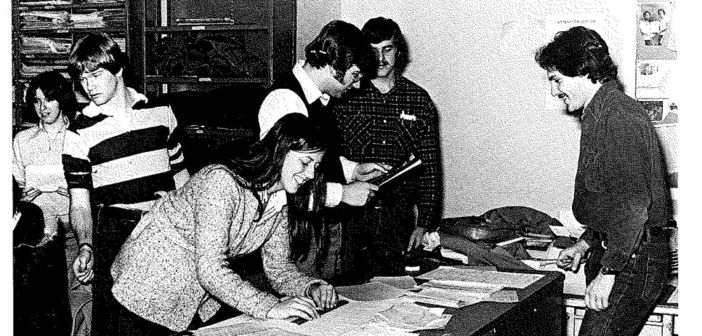

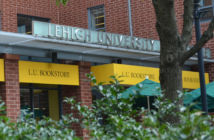
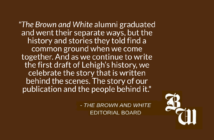
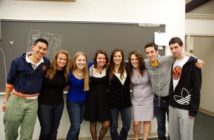
Comment policy
Comments posted to The Brown and White website are reviewed by a moderator before being approved. Incendiary speech or harassing language, including comments targeted at individuals, may be deemed unacceptable and not published. Spam and other soliciting will also be declined.
The Brown and White also reserves the right to not publish entirely anonymous comments.